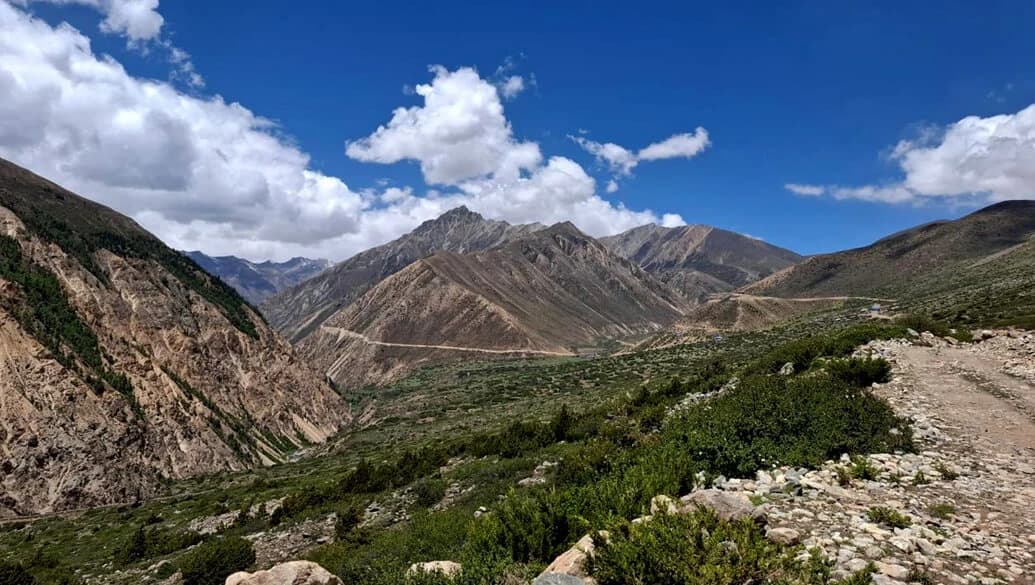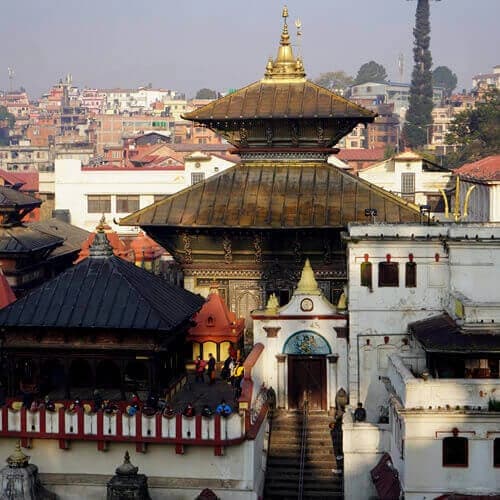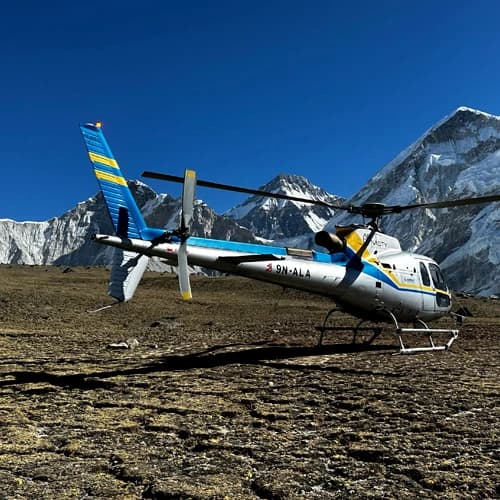Highlights of Your Limi Valley Journey
- Meeting Local Communities: Engage with the region's native people in villages like Til, Halji, and Jang. These settlements are close to the Tibetan border and feature attractions like the 800-year-old Rinchhen Ling Gompa Monastery and Chagzur Hot Spring.
- Crossing High Mountain Passes: Conquer the high passes of Langdogd (4,550m/14,928ft), Nyalu La (4,990m/14,000ft), and Nara La (4620m).
- Spectacular Views of Mount Kailash: Enjoy mesmerizing views of the sacred Mount Kailash (6,638m/21,778ft) and other peaks like Mt. Saipal (7,031m/23,068ft), Kanjiroba (6,883m/22,582ft), and Mt. Api (7,132m/23,399ft).
- Panoramic Himalayan Scenery: Hike on an ancient caravan trail in Talung Valley, which joins Limi Valley to the Mansarovar Trail. The landscape is vibrant, with lush pine forests and green vegetation.
- Wildlife Exploration: Opportunity to witness species like blue sheep, wild yak, musk deer, and barking deer while walking alongside the Chumsa Khola Valley.
- Vibrant Ancient Tibetan Monasteries: Visit the Namkha Khyung Dzong (the biggest in Humla), Dhungkar Choezom Monastery in Tumkot (the only Shakya Monastery in Humla), Lhundrup Choeling Gompa, Laikyo Gompa, and Rinzin Ling Gompa.
- Cultural Immersion: Witness and learn about the ancient crafts and culture in Kermi Laikyo Gompa and Lhundrup Choeling Gompa in Kermi village.
18-Day Limi Valley Trek: An Unforgettable Journey into Remote Nepal & Tibetan Culture
The Limi Valley Trek in Nepal is a challenging journey in the remote parts of the Humla district. It Offers trekkers stunning mountain scenery, Tibetan cultural immersion, and the opportunity to witness elusive wildlife like blue sheep and snow leopards. In this 18-day Himalayan trip, you will be traveling the untouched and raw landscape of the Far Western region of Nepal. The area is renowned for its pristine beauty and features traditional villages like Halji, Til, and Jang, offering a glimpse into the conventional way of life in the Himalayas.
The Limi Valley Trek Nepal was opened to foreigners in 2002, and its trail follows the ancient tradition and pilgrims route close to the Nepal-Tibet border. To protect the fragile ecosystem of the valley, only limited permits are issued by the government every year. The off-the-beaten adventure typically commences from Simikot, which is accessed by domestic flights from Nepalgunj. During the scenic flight, you will have glimpses of majestic mountains, including Saipal, Byas, Rishi, Api, Kanjirowa, and Kanti in Nepal, as well as the revered holy Mount Kailash across the border in Tibet.
This off-the-beaten-path adventure mostly follows the course of the Karnali River, winding its way through remote and culturally rich Limi Valley. You will gain significant altitude in this trek, with the highest being 4,990m/14,000ft at Nyalu La Pass. Trekkers will experience a primarily camping-style expedition, with basic tea houses available at lower altitudes. You can undertake the trip between May and October, with July and August also being ideal times due to the region's rain shadow effect.
Why Embark on the Limi Valley Trek?
For travel enthusiasts drawn to the allure of the Himalayas and desire an adventure in the remote wilderness, the Limi Valley Trek offers an experience unlike any other. This journey follows an ancient salt trading route, culminating in spectacular views of the revered Mountain Kailash. Additionally, the trek blends profound cultural immersion, natural beauty, and a true sense of exploring the untouched wilderness. Here are some compelling reasons why the Limi Valley Trek is a unique trek and the factors that make it special:
- An Off-the-Beaten-Path Experience: The Limi Valley was only opened to foreigners in 2002, solidifying its status as a genuinely "less-traveled" and "remote" region. This aspect offers travelers an authentic, quieter, and solitary trekking experience compared to other popular treks.
- Cultural Immersion and Discovery of Tibetan Heritage: The trek offers a rare opportunity to immerse yourself in the vibrant, preserved Tibetan culture and lifestyle. The journey includes visits to ancient Buddhist monasteries, including Rinzin Ling Gompa, Dhungkar Choezom Monastery, Laikyo Gompa, and Lhundrup Choeling Gompa.
- Breathtaking Himalayan Landscapes: You will be treated to stunning panoramic vistas of mountains, including Kailash, Saipal, Byas, Rishi, Api, Kanjirowa, Kanti, Dhaulagiri, Tukuche, Nilgiri, and the Annapurna Massif.
- Rich Wildlife Encounters: The Humla region is a habitat for diverse flora and fauna. It offers the chance to encounter endangered species like musk deer, wild yak, blue sheep, barking deer, and even the elusive snow leopard.
- Unique Monsoon Season Advantage: Unlike other trekking regions in Nepal, the Limi Valley is located in a rain-shadow area. This means the summer or monsoon season (July and August) is ideal for trekking. During this time, Humla experiences sunny and dry days with lush greenery covering the landscapes.
Is previous trekking experience necessary for the Limi Valley Trek?
While previous trek experience is not strictly mandatory, it is strongly recommended for trekkers to be fit and healthy for a safe and enjoyable journey. Given the trek's high altitude and demanding nature, it is characterized as "strenuous," "demanding," and "moderately difficult." This Himalayan adventure requires you to be in physically good shape, possessing robust stamina, strength, and cardiovascular capability to cope with low oxygen density in high elevation. So, it is crucial to make adequate physical preparation for at least 3 months of training from the departure date of the trek. Here are some additional details you must consider before deciding to embark on the Limi Valley Trek:
- Prior Experience is Not Needed: Individuals in good health and fitness are capable of hiking on high-altitude terrains without overexerting themselves. Proper physical shape is highly advised for maximum enjoyment of this Himalayan adventure.
- Recommended preparation: Engage in activities that simulate long-distance hiking, such as jogging, running, treadmill running, swimming, and cycling,
- Health Consultation: We suggest you consult your doctor to assess pre-existing conditions. It is essential to determine whether such underlying conditions might affect your stamina, coordination, range of motion, and balance.
Best Time to do the Limi Valley Trek
The optimal period for undertaking the Limi Valley Trek is during the spring (March, April, May) and autumn (September, October, November) seasons. These months of the year offer clear visibility, mild weather, favorable temperatures, and clear visibility, making for a pleasant trek experience. A unique aspect of this adventure is that it can be commenced even during summer or monsoon (July and August) due to its distinctive location. The region falls in the rain shadow area, which means it experiences sunny and dry days, while most areas of Nepal receive rainfall. Lim Valley is ideal if you miss spring and autumn to experience an off-the-beaten trek, even during the monsoon season. For more information, here are some key details regarding the best time to do the Limi Valley Trek:
Spring (March, April, Ma):
- Temperature: It ranges approximately 4°C to 10°C, with a low of -12 °C at night in March and early June.
- Weather conditions: The sky is clear and cloud-free, providing panoramic views of the mountains.
- Trail: The trek routes are adorned with lush and vibrant rhododendrons and green vegetation.
Autumn (September, October, November):
- Temperature: It averages around °C in September and November, with daily highs up to 25°C during the day and 10°C at night.
- Weather conditions: The atmosphere is pristine, with a stable climate and occasional rain and snow.
- Trail: The routes are dry and generally free from heavy snow, rain, and mud.
Summer/Monsoon Season (July, August):
- Temperature: Typically ranges from 10°C to 20°C.
- Weather: The climate is ideal for trekking due to the rain shadow effect, resulting in sunny and dry days.
- Trail Conditions: The landscape is covered by lush greenery and colorful hues of wildflowers.
Winter Season (December, January, February):
- Temperature: Can drop below freezing to -20°C.
- Weather: The sky is covered with clouds, and the landscape is surrounded by mist with occasional sunlight.
- Trail Conditions: The high mountain passes might be impassable due to the thick layer of snow.
Trekking Permits You Need for the Limi Valley
To access the remote region of Humla, you will need a Restricted Area Permit. To obtain the permit, there must be a minimum number of two trekkers in a group. It will cost you around USD 50 per person for 7 days and USD 10 per person per day thereafter. We organize the trek permit on your behalf. All you need to do is send us the necessary documents, including your passport copy, passport-sized photos, travel insurance, flight tickets, etc. Apart from the Restricted Area Permit, here are two other permits you will need to access the Humla region:
- TIMS Card (Trekkers’ Information Management System)/ USD 20 per person (for group trekkers with a guide)
- Karnali Conservation Area Permit (KCAP)/ USD 8 to 10 per person
Why You Need a Permit
Humla is a restricted area because of its proximity to Tibet. Your permit number will be noted down at several checkpoints. This will help the authorities understand if you go missing. It is a thoughtful maneuver that increases the chances of search parties finding you in the right location.
Note: If you get lost in the mountains, do not stray from the main trail and stay where you are. As soon as you go missing, we will arrange a rescue mission to find and escort you back to safety.
Limi Valley Circuit Accommodation and Meal: It is a camping trek
The Limi Valley Trek Nepal is predominantly a camping-style expedition in the Himalayas. This means you will stay overnight in tents, immersing yourself in the remote wilderness of the Humla region. This self-supported approach is integral to the authentic, off-the-beaten experience of the trek. We will pre-arrange all the necessary camping equipment and gear for seamless travel. Our staff will cook the food using organic and hygienic ingredients. Also, please note that there are a few teahouses at the starting section of the trail. You can stay at these basic accommodations before dedicating yourself to the outdoor adventure in the wild. This blend of robust camping and teahouse stays offers a comprehensive experience of the region's authentic hospitality. Here are some other key details regarding accommodation and meals on the Limi Valley Trek.
- Primary Accommodation: You will stay at camp for most nights during the journey. Our team members will arrange a makeshift toilet away from the settlements to maintain a clean environment.
- Equipment: We arrange all the essential camping equipment and kitchen utensils, which are included in the trek package.
- Lodge/Teahouse Availability: These establishments offer a clean room with beds, mattresses, pillows, bed sheets, and blankets on a twin-sharing basis.
- Meals and cuisines: The teahouses offer breakfast, lunch, and dinner, and you can choose from numerous cuisines, including authentic Nepali, Tibetan, and even some basic Western dishes.
Limi Valley Trek Cost Details
The total cost for the 18-day Limi Valley Trek can vary depending on the route, comfort level, services provided, and group size. On average, you can expect to spend anywhere from USD 800 to USD 1500 for a standard package. This price usually covers most of the essentials you'll need throughout the journey — from accommodation and meals to permits and logistics.
Since the Limi Valley lies in a remote part of northwestern Nepal, close to the Tibetan border, travel arrangements and support services tend to be more extensive and logistically demanding than in more popular trekking regions. Below is a detailed breakdown of what’s typically included and not included in a basic package.



